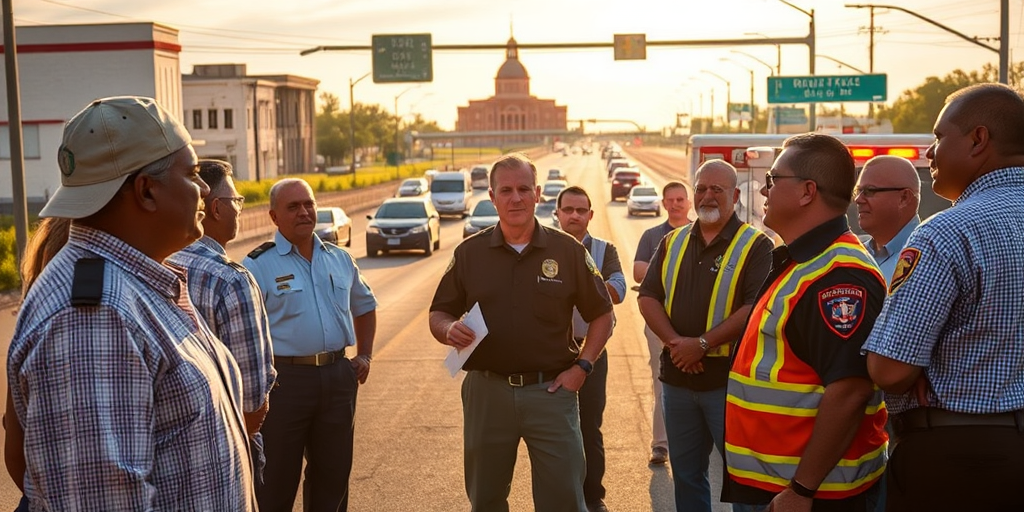TxDOT Tests Contraflow System to Expedite Emergency Evacuations in the Rio Grande Valley
In a significant step toward ensuring the safety and preparedness of the Rio Grande Valley (RGV) in emergencies, the Texas Department of Transportation’s (TxDOT) Pharr district recently conducted a crucial exercise. This drill, aimed at testing the practice known as “contraflow,” involves utilizing both sides of the expressway to direct evacuation traffic in one direction, significantly accelerating the evacuation process during extreme situations.
A Glimpse into Contraflow: Ensuring Swift Exits
The concept of contraflow isn’t new but is a vital part of emergency management strategies, particularly in regions susceptible to natural disasters. In the face of imminent threats such as hurricanes, the need for swift and organized evacuations becomes paramount. As such, TxDOT’s practice and testing of contraflow, which employs all lanes of an expressway to flow traffic in a single direction, is a critical preparation measure.
During the exercise, conducted in coordination with emergency management services, no ramps were closed — a state maintained to prevent disrupting regular traffic. However, in a real-world scenario, 72 entrance ramps on I-69C southbound and I-2 eastbound would be closed to ensure a streamlined traffic flow toward safety.
Local Impact: Safety and Preparedness in Focus
For the RGV, a region no stranger to severe weather, the implications of the successful implementation of contraflow are far-reaching. The ability to swiftly evacuate residents not only ensures their safety but also demonstrates a high level of preparedness and resilience within the community — illustrative of proactive governance.
“The safety of our residents is our top priority. This exercise showcases our commitment to ensuring that in the event of a disaster, we have efficient systems in place,” commented Rebecca Gonzalez, a local emergency management official, underscoring the importance of such initiatives in protecting Valley residents.
Echoes from the Past: Evacuation Challenges
The RGV’s history with hurricanes and severe weather events highlights the critical need for efficient evacuation procedures. Past instances have seen congested roads during emergencies, prompting calls from residents and officials alike for improved traffic management systems during evacuations.
Carlos Alvarez, a community member affected by Hurricane Dolly in 2008, recalled the chaotic evacuations. “Getting out of the Valley felt like an endless wait. A well-planned contraflow system would have made a huge difference then, helping us leave safely and swiftly,” he shared.
Anticipating Future Needs: The Importance of Preparation
While the current exercise lays the groundwork for effective emergency responses, it also presents opportunities for further community engagement and education about evacuation routes and procedures. As part of this ongoing effort, TxDOT has made resources available for residents to familiarize themselves with the region’s evacuation plans and routes.
Local authorities also encourage Valley residents to actively participate in community meetings and discussions on disaster preparedness. Continued collaboration between TxDOT, emergency management teams, and residents is pivotal as the region readies itself for potential future challenges.
Balancing Perspectives: Weighing the Pros and Cons
While contraflow systems offer clear benefits in expediting evacuations, they are not without challenges. Concerns about the potential for confusion and logistical issues during implementation remain. Some experts advocate for extensive public education campaigns to ensure residents are well-informed about the evacuation process and routes.
Dr. Linda Chavez, a transportation analyst, emphasized the need for clarity and public awareness. “Contraflow is a powerful tool, but its success depends on clear communication and understanding among the public. It’s vital that residents know what to expect and how to proceed during an evacuation,” she noted.
Community Resources and Engagement
For further information, residents are encouraged to visit TxDOT’s website by searching for “hurricane evacuation routes” to access detailed maps and guidelines. Additionally, local officials plan to organize public workshops aimed at educating the community about the contraflow system and broader disaster preparedness strategies.
As TxDOT and local emergency management agencies continue to refine their strategies and engage with the community, the RGV stands as an example of proactive planning and resilience. These efforts not only ensure the safety of Valley residents but also strengthen the region’s capacity to face future challenges with confidence and preparedness.







